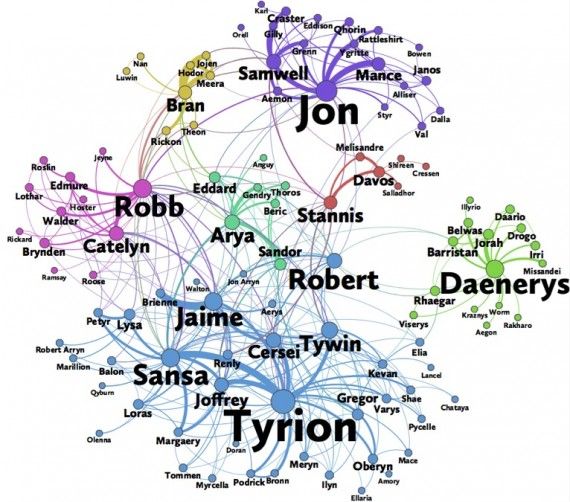Winter is over, and Game of Thrones (2011) is coming back. Based on George R. R. Martin's A Song of Ice and Fire series, the popular HBO television show has made headlines both for its numerous awards and accolades (most recently winning twenty-six Primetime Emmys) and for its arguably gratuitous use of sexual violence and gore. The upcoming sixth season marks a new opportunity for characters to get revenge and for the showrunners to answer the questions that fans have.
One of the most striking characteristics of Game of Thrones, however, is its scope. Game of Thrones does not tell a story so much as it creates a world of interwoven stories and characters - since the central premise revolves around different political factions and figures competing to become the ruler of the Seven Kingdoms of Westeros, it features an ever-changing ensemble cast of characters. Game of Thrones' lack of a protagonist or central character places it in contrast to the majority of television shows on television, and this distinction changes how it approaches storytelling. The series is able and willing to kill any character at any time - since no character is the "main" character, every character is expendable. This means that Game of Thrones has featured a number of shocking and gruesome deaths over the years. This deadly reality permeates the show as a whole, making the threat of a grisly end seem not only possible, but in some cases probable.
It's possible that hindsight will color how future viewers see Game of Thrones; after the show's conclusion, the arc of the narrative might be more clear. A specific character's rise to power might put an added weight on whose story is truly central. But for the current audience that is watching both the show and book series unfold, any ending and any champion seems about as likely as the next. After the show's conclusion, there could be a clear protagonist, but at the moment there is no way to predict who will live or die, or say for certain whose story is being told.
Except, perhaps, for mathematics. Mathematicians have decided to apply formulas and theories to the world of Westeros in an effort to make sense of the many characters and plots of Game of Thrones. The understandings and predictions that these mathematical models have generated are insightful and help to answer - or at least explore - some questions that fans have.
Who is the main character of Game of Thrones?
Earlier this month, Andrew Beveridge and Jie Shan published an academic article in the Mathematical Association of America's Math Horizons entitled Network of Thrones. Beveridge and Shan applied network science, an extension of graph theory, to explore the relationships between characters, and to see if they could find the show's protagonist. Network science has been used for a variety of different applications, from search engines to analyzing and predicting the make-up of terrorist or criminal organizations. By analyzing proximity and interaction between characters in A Storm of Swords, Beveridge and Shan developed a social network examining how and with whom characters related. By then examining and placing certain weight on these relationships, the two analyzed characters based on their number of relationships, the importance of certain relationships, and the number of connections within a character's central community and with other communities.
Beveridge and Shan found that there were three characters who performed best in these network measurements. Sansa Stark held (to the surprise of Beveridge and Shan) the third greatest placement and weight in the network; Jon Snow took second place, and scored highest in "Betweenness," which examined his relationship to diverse communities. In all five of the other metrics, however, Tyrion Lannister took the top seat.
This is perhaps not surprising, as other numeric metrics have favored Tyrion as well. With forty-nine point-of-view (POV) chapters across the novels, Tyrion is the character with the most amount of narration told from his perspective over the course of the series.
The mathematics is also not surprising to viewers of the television show, even if they would not have selected Tyrion as the one-and-only protagonist. Peter Dinklage, who plays Tyrion in the television series, is a central character who has appeared and played a prominent role for the entirety of the television series. This added weight, however, might be both a predictor of Tyrion's role in the series as a whole and might be a clue that he is likely to survive the conclusion of the bloody show.
Is Jon Snow Dead?
The end of season 5 saw Jon Snow stabbed multiple times and left for dead as he bled out onto his namesake. This left many fans wondering: was Jon Snow dead? Statistically, the answer seems to be: probably not. In 2014, mathematician Richard Vale used statistics based on the number of POV chapters in Game of Thrones to create a study called Baysian Prediction in The Winds of Winter. This study predicted which characters would likely die in upcoming installments of Martin's books. While Vale's model does not account for the events in the book, he pointed out that statistically, there was a 60% chance that Jon Snow was still alive.
More recently, students at the Technical University of Munich created A Song of Ice and Data, which examines a number of different factors and computes a percentage that guesses the likelihood of death for different Game of Thrones characters. The higher the percentage, the more likely that the character is going to die. Using a computer that analyzes patterns in characters who have died - including but not limited to gender, class, age, and relations to other characters - data about 2000 Game of Thrones characters were analyzed in order to generate the likelihood of any given character's death. As A Song of Ice and Data points out, while there are twice as many male characters in Game of Thrones, women are much more likely to survive - 43% of male characters die by the end of the fifth book, whereas only 21% of female characters have died.
Jon Snow currently has an exceptionally low percentage of 11%, making him less likely to die than Cersei Lannister (16%), Tyrion (70%), or Daenerys Targaryen (with a shockingly high 95%). Sansa, meanwhile, is one of the least likely characters to die with only a 3% chance. Despite the events of the previous season, A Song of Ice and Data has made it clear that they do not believe that Jon Snow has died.
These predictions, however, are obviously not able to account for all of the nuance of storytelling. Many fans believe that Cersei or Sansa are more likely to die than Daenerys or Tyrion. Additionally, since Game of Thrones goes out of its way to shock people, it may be more likely to break existing patterns and conventions in favor of shocking its audience, which makes data difficult to predict. Perhaps Tyrion's influential place within the network makes him a target rather than safe; perhaps the unlikeliness of Sansa's death will make it all the more shocking. Whether or not mathematics is able to predict the rise or fall of characters is yet to be determined, but the events of season six will help to bolster or disprove these hypotheses, as well as provide more data for any aspiring mathematicians.
Game of Thrones airs its season 6 premiere on Sunday, April 24 at 9pm on HBO.





